Marine Protected Area Network - 2018 Report to the Scottish Parliament
A report to Parliament on progress being made in
implementing a Marine Protected Area (MPA) network.
Our seas
Scotland's position at the edge of the north-west European continental shelf has a huge influence on our coasts and seas. Our marine environment has been shaped by wind, water, and ice over thousands of years, creating productive and abundant marine life.
Infographic:
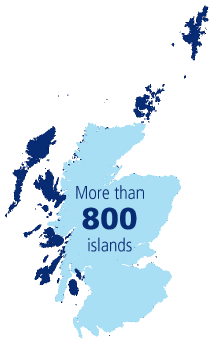
Infographic text:
Scotland had more than 800 islands
The meeting and mixing of nutrient-rich waters provides the perfect home for sea life to thrive. Scotland is of international importance for marine biodiversity providing the ideal environment for our spectacular birds, marine mammals and fish as well as for the habitats that are hidden on the seabed.
The productive nature of our marine environment also supports a wide range of industries, which benefit from the natural resources that our seas provide. Safeguarding the continued supply of these natural benefits is one of the reasons for having the Scottish MPA network.
Coastal habitats support a wealth of plants and animals including marine birds and seals. Saline lagoons and estuarine habitats mark the transition from freshwater to seawater, with specialist plants and animals able to cope with the dramatic changes in salinity and temperature. Many bird species come to these areas as a safe haven for the winter months.
Infographic:
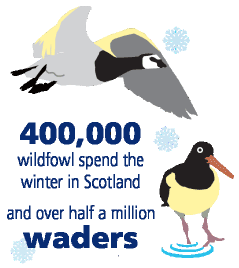
Infographic text:
400,000 wildfowl spend the winter in Scotland and over half a million waders
The complex and variable coastline is mirrored by a diversity of productive habitat forming species such as kelps, seagrasses, blue mussels and maerl. These habitats support a rich diversity of other species and also capture and store carbon.
Infographic:
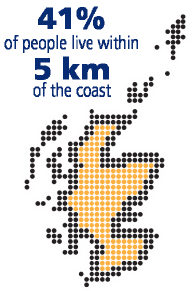
Infographic text:
41% of people in Scotland live within 5km of the coast
Seals can be found foraging in coastal waters, or hauled out on rocks all around the coast. The Moray Firth on the east coast is home to the world's most northerly population of bottlenose dolphin, whilst the Firth of Forth is globally important for breeding seabirds.
Infographic:
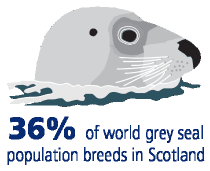
Infographic text:
36% of world grey seal population breeds in Scotland
Infographic:
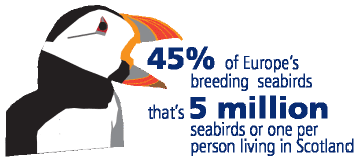
Infographic text:
45% of Europe's breeding seabirds that's 5 million seabirds or one per person living in Scotland
The continental shelf is dominated by large sediment plains made up of sands, gravels, and burrowed mud. These habitats are home to a wide range of species, such as the ocean quahog which is capable of living for hundreds of years.
Sandeels, a key prey species for seabirds and marine mammals, are found on sandbanks throughout our seas.
Infographic:
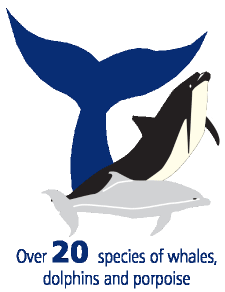
Infographic text:
There are over 20 species of whales, dolphins, and porpoise found in Scotland's seas
Beyond the continental shelf lies the deep sea. This vast area is divided by the Wyville-Thomson ridge which causes variation in the marine life on each side. To the north the Faroe-Shetland Channel is dominated by cold Arctic waters. To the south the Rockall Trough is dominated by warmer Atlantic waters and has three underwater mountains, known as seamounts, which are taller than Ben Nevis.
Infographic:
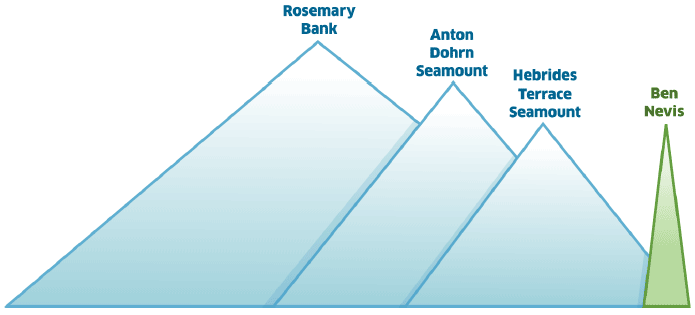
Infographic text:
Scotland has 3 underwater mountains which are taller than Ben Nevis
The history of Scotland's seas survives underwater in the form of wrecks of boats, aircraft, or artefacts from submerged pre-historic landscapes. This cultural heritage helps us to appreciate the importance of our seas throughout Scotland's history. This combination of natural and cultural heritage enhances the distinctiveness of our special seas.
Infographic:
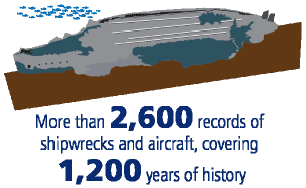
Infographic text:
In Scotland's seas there are more than 2.600 records of shipwrecks and aircraft, covering over 1,200 years of history
Our seas remain at the forefront of our food and energy needs, through fishing, aquaculture, oil and gas, and renewable energy. They are also important for recreation and marine tourism. The fishing industry in Scotland has strong cultural and historical links with our seas. As an island nation being able to trade goods through marine transportation provides links to other nations.
The productivity of fish stocks is closely linked to the quality of the marine environment and the supply of fresh fish and shellfish is an important service that the marine environment provides to the Scottish economy.
Scotland also has the largest wave, tidal and offshore wind resource in Europe.
Infographic:
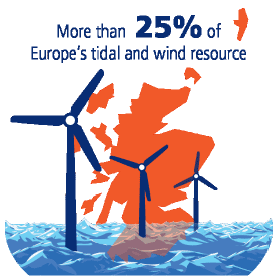
Infographic text:
Scotland's seas have more than 25% of Europe's tidal and wind energy resource
Infographic:
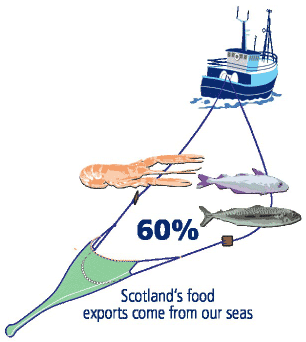
Infographic text:
60% of Scotland's food exports come from our seas
In 2016 the Scottish Marine Economy (excluding oil and gas extraction) generated £3.8 billion GVA (Gross Value Added), providing employment for over 75,000 people.
Infographic:
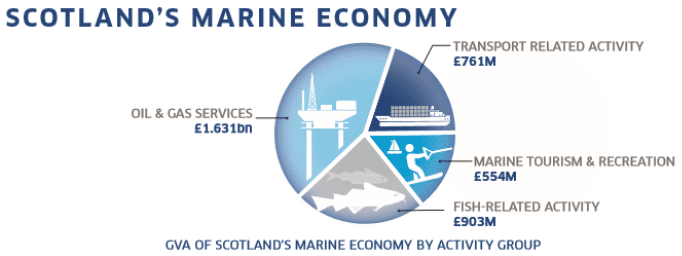
Infographic text:
Scotland's marine economy generated £3.8 billion of gross value added in 2016
Some benefits from nature are direct - fish to eat or wildlife to watch. Others are less obvious, such as kelp forests, beaches and dunes limiting coastal erosion, or the capture and storage of carbon in seabed sediments. These services lead to substantial economic benefits to society. Our seas also sustain well-being through our physical and mental health ('the natural health service').
Infographic:
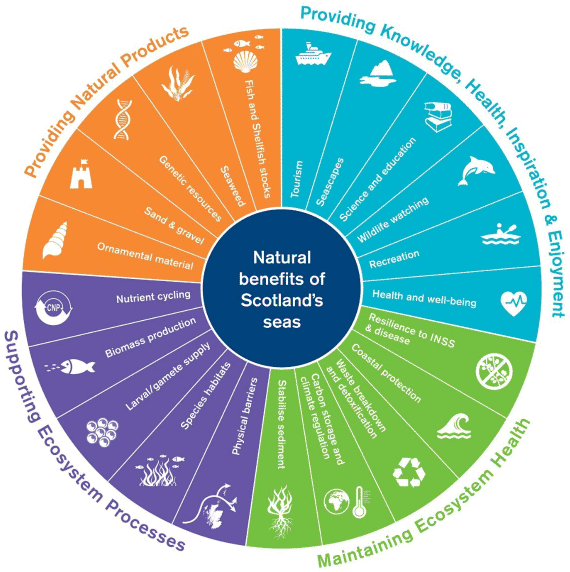
Infographic text:
The natural benefits of Scotland's seas
Looking after our seas requires a range of different management approaches. This includes marine planning and licensing together with various different statutory and voluntary codes and good practice. Doing so is vital to ensuring that society can continue to derive the many natural benefits that our seas provide.
MPAs also have an important role to play in conserving our seas. They enable the focused protection of habitats and species which are essential to the marine ecosystem. This facilitates an increase in ecosystem resilience and recovery of habitats and species where required.
The Scottish MPA network consists of nature conservation sites designated under various legislative frameworks. These protect a wide range of habitats and species. It also includes other areas which deliver nature conservation benefits, known as Other Area Based Measures. Also included are sites designated to protect our historic environment and for demonstration and research purposes.
Infographic:
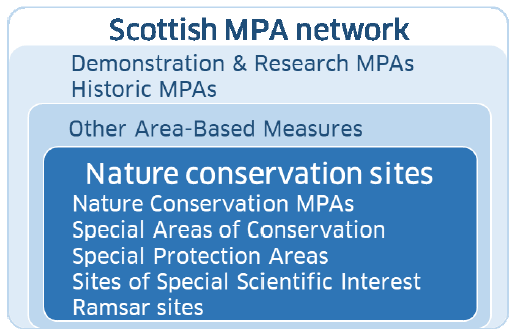
Infographic text:
Scottish MPA network
Demonstration & Research MPAs
Historic MPAs
Other Area-Based Measures
Nature conservation sites
Nature Conservation MPAs
Special Areas of Conservation
Special Protection Areas
Sites of Special Scientific Interest
Ramsar sites
Contact
Email: Michael McLeod
There is a problem
Thanks for your feedback